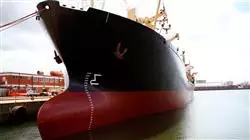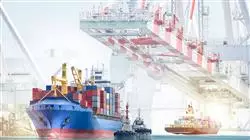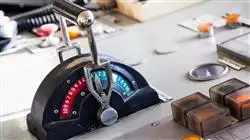University certificate
The world's largest faculty of engineering”
Description
Learn to design, evaluate and manage Naval and Ocean Engineering projects using the most up-to-date and innovative techniques in the sector”

The Professional master’s degree in Naval and Ocean Engineering includes all the stages in the life of a naval project, including the main areas of work, from feasibility studies, conceptual, basic and detailed engineering or production, to shipyard deliveries and ship operations from the point of view of shipowners, as well as all the new trends in technologies and processes in the naval market.
The program will review the available software that increases computing power in naval engineering and it will address the stages in production, as well, including the most current approaches using the latest organizational measures in production and excellence, so students have a vision of a complete approach from the points of view of engineering, production and operations.
It must be noted that naval engineering is undergoing digital transformation, which is why this Naval and Ocean Engineering will cover the digital transformation of business structures using new tools and new technologies.
The naval engineering sector is a global market, so all companies must be structured and oriented nationally and internationally if they want to be competitive. Following this criterion, this educational program will focus on the concept of globalization and will explore the opportunities offered by the global market using information on existing grants, programs and European commissions.
Furthermore, new visions are brought to the field of naval engineering, updating knowledge with new emerging innovative technologies and industry 4.0 for all the agents involved in the life of a project, putting the focus on business from the point of view of shipowners, shipyards and engineering.
As it is a 100% online Professional master’s degree, students will not be constrained by fixed schedules or the need to commute to another physical location, rather, they can access the contents at any time of the day, balancing their work or personal life with their studies.
The completion of thisProfessional master’s degree will place Naval and Ocean Engineering professionals at the forefront of the latest developments in the sector”
This Professional master’s degree in Naval and Ocean Engineering contains the most complete and up-to-date academic program on the market. The most important features include:
- Practical cases presented by experts in Naval and Ocean Engineering
- The graphic, schematic, and eminently practical contents with which they are created, provide scientific and practical information on the disciplines that are essential for professional practice
- Practical exercises where self-assessment can be used to improve learning
- Special emphasis on innovative methodologies in Naval and Ocean Engineering
- Theoretical lessons, questions to the expert, debate forums on controversial topics, and individual reflection assignments
- Content that is accessible from any fixed or portable device with an Internet connection
This Professional master’s degree is the best investment you can make in selecting a refresher program in the field of Naval and Ocean Engineering . We offer you quality and free access to content"
The teaching staff includes professionals from the naval engineering sector, who bring their experience to this update program, as well as renowned specialists from leading societies and prestigious universities.
The multimedia content, developed with the latest educational technology, will provide the professional with situated and contextual learning, i.e., a simulated environment that will provide immersive training programmed to train in real situations.
The design of this program focuses on Problem-Based Learning, which means the student must try to solve the different real-life situations of that arise throughout the academic program. For this purpose, the professional will be assisted by an innovative, interactive video system created by renowned and extensively experienced experts in Naval and Ocean Engineering.
This program comes with the best educational material, providing you with a contextual approach that will facilitate your learning"

This 100% online Professional master’s degree will allow you to balance your studies with your professional work. You choose where and when to train"
Syllabus
The content of this Professional master’s degree structurally covers all the areas of knowledge that professionals need to know in depth, including the most interesting news and updates in the sector. A high quality academic experience that will allow you to compete with solvency and sufficient capacity in creating and developing Smart City systems.

Comprehensive, stimulating and innovative, our syllabus will allow you to acquire, complete or update your knowledge of Naval and Ocean Engineering on a program of exceptional quality”
Module 1. The Life Cycle of Naval Projects
1.1. The Life Cycle of Naval Projects
1.1.1. The Life Cycle
1.1.2. Stages
1.2. Negotiation and Feasibility
1.2.1. Viability Analysis: Generating Alternatives
1.2.2. Budgets
1.2.3. Negotiation
1.2.4. Contracts and Execution
1.3. Conceptual Engineering
1.3.1. Conceptual Design
1.3.2. General Provisions
1.3.3. Technical Specifications
1.3.4. Relevant Conceptual Project Information
1.4. Basic Engineering Structures
1.4.1. Structural Systems
1.4.2. Calculation Methodologies
1.4.3. Beam Vessel Theory
1.5. Basic Machinery and Electrical Engineering
1.5.1. Propulsion
1.5.2. Services
1.5.3. Electricity
1.6. Development Engineering
1.6.1. Construction Strategy and Manufacturing Constraints
1.6.2. 3D Modeling and Operations
1.7. Production and Maintenance
1.7.1. Construction Strategies
1.7.2. Budget and Planning
1.7.3. Production Organization
1.7.4. Outsourcing
1.7.5. Purchasing and Logistics Management
1.7.6. Quality Control
1.7.7. Monitoring and Control
1.7.8. Delivery and Commissioning
1.8. Shipyard Management
1.8.1. Strategy
1.8.2. Sizing and Investments
1.8.3. Human Resources and Raining
1.8.4. Auxiliary Industry
1.8.5. Plant Maintenance and Reliability
1.8.6. Financial Management
1.8.7. Quality
1.8.8. The Environment
1.8.9. Occupational Risk Prevention
1.8.10. Continuous Improvement and Excellence
1.9. Exploitation
1.9.1. Departure from the Shipyard
1.9.2. Start of Operations
1.9.3. Ports
1.9.4. Scrapping
1.10. Innovation and Development
1.10.1. R&D&I in New Technologies
1.10.2. R&D&I Engineering
1.10.3. R&D&I in Energy
Module 2. Negotiation and Feasibility
2.1. Market Research
2.1.1. Market Research Startup Conditions
2.1.2. Key Points in Market Research
2.2. Feasibility Studies
2.2.1. Time Calculations (Cargo Management, Ports and Routes)
2.2.2. Capacity Calculations (Quantities to Be Transported)
2.2.3. Cost Calculation
2.2.4. Lifespan
2.3. Decision Matrix
2.3.1. Decision Matrix Design
2.3.2. Decision Making
2.4. Budget
2.4.1. Budget Types
2.4.2. CAPEX
2.4.3. OPEX
2.4.4. Project Financing: Grants and Subsidies
2.5. Relationship between Shipowners and Technical/Shipyard Offices
2.5.1. Shipowner-Technical Office
2.5.2. Shipowner-Shipyard
2.6. Requesting and Assessing Bids
2.6.1. Information Required for Bids
2.6.2. Homogenization of Bids
2.7. Negotiation Techniques
2.7.1. Concept of Negotiation
2.7.2. Negotiation Types
2.7.3. Negotiation Phases
2.8. Classification Society and Flags
2.8.1. Classification Societies
2.8.2. Flags
2.9. Construction Contracts
2.9.1. Types of Contracting
2.9.2. Payment Milestones
2.9.3. Penalties
2.9.4. Contract Cancellation
2.10. Contract Monitoring
2.10.1. Inspection Teams
2.10.2. Cost Control
2.10.3. Risk Analysis and Monitoring
2.10.4. Variations and Extras
2.10.5. Warranties
Module 3. Conceptual Engineering
3.1. Regulation
3.1.1. Statutory
3.1.2. Classification Societies
3.1.3. Additional Regulations
3.2. Vessel Sizing
3.2.1. Main Dimensions
3.2.2. Relation between Dimensions
3.2.3. Main Coefficients
3.2.4. Design Constraints
3.2.5. Alternatives and Final Selection
3.3. Hydrodynamics (I)
3.3.1. Forms
3.3.2. Propulsive Power, Selecting the Type of Propulsive and Steering Equipment
3.4. Hydrodynamics (II)
3.4.1. Theoretical Basis
3.4.2. CFD (Computational Fluid Dynamics)
3.4.3. Channel Tests
3.4.4. Validation during Sea Trials
3.5. General Arrangement and Technical Specifications
3.5.1. Technical Specifications
3.5.2. Compartmentalization
3.5.3. Autonomy
3.5.4. Flag Authorization
3.5.5. Safety and CI
3.5.6. Ventilation
3.5.7. Heating, Ventilation and Air Conditioning (HVAC)
3.6. Stability
3.6.1. Thread Weight and Center of Gravity of the Vessel
3.6.2. Stability (Intact and Damage)
3.6.3. Longitudinal Strength
3.6.4. Validation Using Stability Tests
3.7. Structure
3.7.1. Structural Parameters
3.7.2. Preliminary Master Frame: Steel Weight Estimation
3.7.3. Noise and Vibration
3.8. Machinery
3.8.1. Machine Room Layout, Equipment List
3.8.2. Conceptual Electrical Balance
3.9. Load and Deck Equipment
3.9.1. Loading Equipment
3.9.2. Mooring and Anchoring Equipment
3.10. Vessel Types
3.10.1. Passengers (SRTP)
3.10.2. Weight Vessels
3.10.3. Volume Vessels
3.10.4. Special Vessels
3.10.5. Fishing Vessels and Tugboats
3.10.6. Platforms
Module 4. Structural Engineering
4.1. Calculation Systems
4.1.1. Rule-Based Design
4.1.2. Rationally-Based Design
4.2. Structural Design Principles
4.2.1. Materials
4.2.2. Bottom and Double Bottom Structures
4.2.3. Deck Structure
4.2.4. Liner Structure
4.2.5. Bulkhead Structure
4.2.6. Welding
4.3. Loads
4.3.1. Internal
4.3.2. External
4.3.3. Sea-Related
4.3.4. Specific
4.4. Scantlings
4.4.1. Tertiary Element Calculation
4.4.2. Ordinary Element Calculation
4.5. Primary Element Calculation
4.5.1. New Technologies
4.5.2. Numeric Methods
4.5.3. Bar Numerical Simulation
4.5.4. Shell Numerical Simulation
4.5.5. Submodels
4.6. New Technologies
4.6.1. Software
4.6.2. Models and Submodels
4.6.3. Fatigue
4.7. Key Plans
4.7.1. Digital Twins
4.7.2. Constructability
4.8. Other Structures (I)
4.8.1. Bow
4.8.2. Stern
4.8.3. Engine Space
4.8.4. Superstructures
4.9. Other Structures (II)
4.9.1. Ramps and Side Doors
4.9.2. Hatches
4.9.3. Heliports
4.9.4. Main Engine Mount
4.9.5. Crane Calculation
4.9.6. Rudder and Appendages
4.10. Other Calculations
4.10.1. Anchoring and Mooring Equipment Structure
4.10.2. Anchoring Models
4.10.3. Weight and Preliminary MTO
Module 5. Installation, Machinery and Electrical Engineering
5.1. Current Propulsion Systems and Propellants
5.1.1. Propulsion Systems
5.1.2. Thrusters
5.1.3. Latest IMO Emission Control Regulations
5.2. Main and Auxiliary Engine Services
5.2.1. Regulations
5.2.2. Materials
5.2.3. Equipment
5.2.4. Calculations
5.3. Other Machine Room Services
5.3.1. Regulations
5.3.2. Materials
5.3.3. Equipment
5.3.4. Calculations
5.4. Off-Site Machine Services
5.4.1. Regulations
5.4.2. Materials
5.4.3. Equipment
5.4.4. Calculations
5.5. Fire Services
5.5.1. Regulations
5.5.2. Materials
5.5.3. Equipment
5.5.4. Calculations
5.6. Hotel Services
5.6.1. Regulations
5.6.2. Materials
5.6.3. Equipment
5.6.4. Calculations
5.7. Balance
5.7.1. Thermal
5.7.2. Water
5.8. Ventilation and Air Conditioning
5.8.1. Machine Room Ventilation
5.8.2. Ventilation Outside the Machine Room
5.8.3. HVAC
5.9. Electrical Balance and Single-Line Diagrams
5.9.1. Electrical Balance
5.9.2. Single-Line Diagrams
5.10. Basic Electrical Engineering
5.10.1. Scope
Module 6. Development and Production Engineering
6.1. Construction Strategies
6.1.1. BSA (Build Strategy Approach)
6.1.2. Work Breakdown
6.1.3. Design to Build Engineering
6.2. CADCAM Systems: 3D Ship Modeling
6.2.1. 3D Modeling
6.2.2. Interface with PLM Tools and FEM and CFD Calculations
6.2.3. Constructive Limitations in Design
6.2.4. Virtual Reality, Verifications and Design Reviews
6.3. Steel Detail Engineering
6.3.1. 3D Modeling
6.3.2. Plate Nesting
6.3.3. Profile Nesting
6.3.4. Products (Flat and Curved Plates and Profiles; Pre-Blocks, Sub-Blocks and Blocks)
6.3.5. Assembly: Sub-Blocks and Blocks
6.3.6. Plate and Profile MTO
6.4. Detailed Outfitting Engineering (I)
6.4.1. 3D Modeling of Auxiliary Structures and Equipment Poles
6.4.2. Construction and Assembly Drawings
6.4.3. Plate and Profile MTO
6.4.4. Equipment Layout Drawings
6.5. Detailed Outfitting Engineering (II)
6.5.1. 3D Modeling of Pipelines
6.5.2. Spools
6.5.3. Isometrics
6.5.4. Layout Drawings
6.5.5. Pipes and Fittings MTO
6.6. Detailed Electrical Engineering (I)
6.6.1. 3D Modeling of Electrical Conduits
6.6.2. Arranging Apparatus, Switchboards and Consoles
6.6.3. Listing and Arranging Apparatus in Hazardous Areas
6.6.4. Tray Filling and Electrical Passages
6.6.5. Construction Engineering Machine Control Console
6.6.6. Constructive Engineering Electrical Panels
6.7. Detailed Electrical Engineering (II)
6.7.1. Electrical Diagrams
6.7.2. Cable Lists
6.7.3. Wiring Diagrams
6.7.4. System Wiring Arrangements (Power, Lighting, Communications, Navigation, Fire and Safety)
6.7.5. List of Automated Functions and Alarms
6.8. Accommodation Detail Engineering
6.8.1. Premises Layout
6.8.2. Booth Layout
6.8.3. General Flag Authorization Layout
6.8.4. General Furniture Layout
6.8.5. General Decorative Flooring Layout
6.8.6. Decorative Projects
6.9. Detailed Electrical Engineering (II)
6.9.1. 3D Modeling of Ducts
6.9.2. Construction and Assembly Drawings of Rectangular Section Ducts
6.9.3. Isometric Drawings of Circular Section Ducts
6.9.4. Ducts Layout Drawings
6.9.5. Detailed Drawings of Flanges and Fittings
6.9.6. Ducts and Fittings MTO
6.10. Maneuvers
6.10.1. Location Plans of Maneuvering Eyebolts to Turn and/or Assemble Blocks and Sub-Blocks
Module 7. Production
7.1. Construction Strategies: Preparation
7.1.1. Division into Blocks and Sections
7.1.2. Physical Shipyard Conditions
7.1.3. Constraints due to Facility Availability
7.1.4. Project Constraints
7.1.5. Supply Constraints
7.1.6. Other Constraints
7.1.7. Implications of Subcontracting
7.2. Budget and Planning
7.2.1. Integrated Construction
7.2.2. Steel
7.2.3. Outfitting
7.2.4. Painting
7.2.5. Other: Electricity, Flag Authorization, Insulation
7.2.6. Testing, Commissioning and Delivery
7.3. Production Organization (I)
7.3.1. Steel
7.3.2. Pre-Outfitting
7.3.3. Engine Room
7.3.4. Main Equipment and Shaft Lines
7.3.5. Cargo and Deck
7.3.6. Electricity
7.3.7. Flag Authorization
7.4. Production Organization (II)
7.4.1. Painting
7.4.2. Insulation
7.4.3. Launching and Floating
7.5. Outsourcing
7.5.1. Advantages and Disadvantages of Outsourcing
7.5.2. Outsourcing Planning
7.5.3. Assessment, Decision Criteria and Awarding Criteria
7.5.4. Outsourcing as a Strategic Competitive Element
7.6. Purchasing and Logistics Management
7.6.1. Technical Specifications
7.6.2. Materials and Equipment Purchasing Plans
7.6.3. Monitoring and Quality Control
7.7. Quality Control and Statistical Control
7.7.1. Statistical Process Control
7.7.2. Statistical Methods Applied to Quality Control
7.8. Monitoring and Control
7.8.1. Monitoring Planning
7.8.2. Cost and Budget Monitoring
7.8.3. Quality Monitoring
7.8.4. Occupational Risk Prevention (ORP) Monitoring
7.8.5. Environmental Monitoring
7.9. Delivery and Commissioning
7.9.1. Test Protocols
7.9.2. Stability Tests
7.9.3. Dock Tests
7.9.4. Sea Trials
7.9.5. Warranties
7.10. Repairs
7.10.1. The Ship Repair Business
7.10.2. Repair Yard Features
7.10.3. Repair Yard Organization
7.10.4. Workflows
7.10.5. Ship Repair Projects
Module 8. Shipyard Management
8.1. Strategy
8.1.1. Strategy Fundamentals
8.1.2. Competitive Environment
8.1.3. Competitive Positioning
8.1.4. Criteria and Methods for Strategic Decisions
8.2. Sizing and Investments
8.2.1. Product Optimization and Strategy
8.2.2. Fixed, Variable and Breaking Even Costs
8.2.3. Investment Analysis
8.3. Human Resources and Training
8.3.1. Human Resources Strategies
8.3.2. Outsourcing and Turnkey
8.3.3. Selection
8.3.4. Compensation and Benefits
8.3.5. Well-Being: Well-Being
8.3.6. People Management: Talent Management Talent Matrix
8.3.7. Development and Training Plans: Internal and External Master's Degrees and Schools
8.4. Auxiliary Industry
8.4.1. The Ancillary Industry as a Competitive Factor
8.4.2. Pros and Cons of Outsourcing
8.4.3. Strategic Implications
8.4.4. Legal Aspects
8.5. Plant Maintenance and Reliability
8.5.1. Maintenance Organization
8.5.2. Current Maintenance Techniques
8.6. Financial Management
8.6.1. Financial Management
8.6.2. Cash Flow and Financial Planning
8.6.3. The Time Value of Money: Interest Rates
8.6.4. Risk and Return: The Cost of Capital
8.6.5. Budgeting Techniques
8.6.6. Leverage and Capital Structure
8.6.7. Shipbuilding Aid
8.7. Quality
8.7.1. ISO Business School 9001
8.7.2. Quality Policy
8.7.3. Quality Objectives
8.7.4. RACI Matrix
8.7.5. Integrating ISO Management Systems
8.8. The Environment
8.8.1. ISO 14001
8.8.2. Environmental Management
8.9. Risk Prevention
8.9.1. ISO 45001 Improving Occupational Health and Safety Performance
8.9.2. Occupational Health and Safety Services
8.9.3. Strategies for Safety and Health at the Workplace
8.9.4. Occupational Safety and Health Administration (OSHA)
8.10. Continuous Improvement and Excellence
8.10.1. Continuous Improvement Tools
8.10.2. Improvements in Material Flow and Plant Layout
8.10.3. Equipment Efficiency
8.10.4. Environmental Improvements
8.10.5. Other Keys to Improvement
Module 9. Naval Vessel Management and Operation
9.1. Basic Vessel Documentation
9.1.1. Vessel Documentation and Permits
9.1.2. Crew Documentation and Permits
9.1.3. Cargo Documentation and Permits
9.1.4. Ship Insurance
9.2. Maintenance
9.2.1. Obligations, Certifications and Flags
9.2.2. Maintenance Plans
9.2.2.1. Preventive Maintenance
9.2.2.2. Predictive Maintenance
9.2.2.3. Corrective Maintenance
9.2.2.4. Maintenance Plan Monitoring
9.2.3. Digital Twins
9.2.4. Quadrennial or Quinquennial Major Repairs
9.3. Port Management
9.3.1. Shipping Agencies or Consignees
9.3.2. Ship Victualling
9.3.3. Permits and Authorizations Vessel Operations
9.4. Personnel Management
9.4.1. Crew: Key Positions
9.4.2. Travel and Boarding Documentation
9.4.3. Personnel Selection
9.4.4. Labor Conditions and Legislation
9.4.5. Crew Transfer
9.5. Ship or Vessel Operations
9.5.1. Civilian Vessels
9.5.1.1. Transport Vessels
9.5.1.1.1. Dry Cargo
9.5.1.1.2. Frozen Cargo
9.5.1.1.3. Fuel Transportation and Vetting
9.5.1.2. Fishing Vessels
9.5.1.3. Support Vessels, Artifacts and Platforms
9.5.1.4. Passenger Vessels
9.5.2. Military Vessels
9.5.3. Maritime Navigation
9.5.3.1. Navigation and Tracking Equipment
9.6. Daily Life on Board, Coexistence
9.6.1. Daily Life on Board
9.6.2. Medical Emergencies and Health on Board
9.6.3. Occupational Risk Prevention on Board
9.7. Port and Navigation Vessel Safety and Integrity
9.7.1. Piracy and Stowaways
9.7.2. Collisions and Naval Boarding Action
9.8. New Technologies in Ship Management and Operations
9.8.1. Enterprise Resource Planning (ERP) and Corporate Tools
9.8.2. Other Management Tools
9.9. Vessel Operating Income Statement
9.9.1. Main KPIS indicators in Vessel Management
9.9.2. Vessel P&L
9.10. Sustainability on Ships
9.10.1. Recycling
9.10.2. Sustainability
9.10.3. Sustainable Fuels
Module 10. Innovation, Development and Research
10.1. New Design Methodologies: Reliability
10.1.1. Risk Analysis
10.1.2. FMEA
10.1.3. HAZID
10.1.4. HAZOP
10.2. Engineering: R&D&I: New Materials
10.2.1. New Materials
10.3. R&D&I: Digital Twins
10.3.1. Products
10.3.2. Production
10.3.3. Performance
10.4. R&D&I: Autonomous Vessels
10.4.1. Autonomous Vessels
10.4.2. Regulations
10.4.3. Difference from Intelligent Vessels
10.4.4. Classification Societies
10.4.5. Examples of Autonomous Vessel Projects
10.5. R&D&I in Energy (I): Alternative Fuels
10.5.1. Liquefied Natural Gas (LNG): The Clean Alternative to Multi-Disciplinary Design Optimization (MDO)
10.5.2. Hydrogen as a Future Naval Fuel
10.5.3. Fuel Cell
10.6. R&D&I in Energy (II): Energy Efficiency
10.6.1. Clean Concepts for Vessels
10.6.2. EEDI: Efficient Vessels
10.6.3. EEOI
10.6.4. SEEMP
10.7. R&D&I in Energy (III): Renewable Energies
10.7.1. Floating Wind Turbines
10.7.2. Wave Energy
10.7.3. Tidal Energy
10.8. Innovation and New Technologies in Construction
10.8.1. Augmented Reality and 3D Vision, Virtual Reality
10.8.2. Productive Improvements Based on Information Management
10.9. Innovation in Operation (I): New Communication Systems
10.9.1. Satellite Systems
10.9.2. Impulse Systems (Sonar, Radars)
10.10. Innovation in Operation (II): Applying Blockchain Technology in Fleet Management
10.10.1. Definition of Blockchain
10.10.2. Application Examples

This training will allow you to advance in your career comfortably"
Professional Master's Degree in Naval and Ocean Engineering
The design, planning and construction of floating artifacts, such as ships, platforms and boats, are activities intimately linked to the maritime development of countries, and, therefore, are also linked to industrial and economic development. Hence, this branch of engineering is subject to constant technological updates. In order to renew the knowledge of the field, TECH Global University created this Professional Master's Degree, whose curriculum covers each stage of the life cycle of a naval project. Thanks to the contents, designed by our teaching team, it will be possible to deepen in the different types of engineering that make up the naval specialty, as well as in the management and operation of shipyards and artifacts. In addition, the analysis of feasibility and negotiation, key elements for the insertion of projects in today's market, will be addressed. At the end of the program, the engineer will be able to establish new approaches to the industry, through the use and application of emerging technologies and methodologies.
Postgraduate Degree in Naval and Oceanic Engineering
In order to be able to respond to the practical needs and solve the challenges that become evident during the construction of naval structures, it is essential to have a set of specialized knowledge and skills in this field. To accompany you in your updating process, TECH offers this Professional Master's Degree focused on the management of structural projects of ships and vessels, at national and international level. In order to facilitate the acquisition of skills, a syllabus has been designed with special emphasis on the digitization of the tasks of naval practice. From the conceptual review and the use of software, aimed at simplifying and perfecting the calculations, the professional will be able to sharpen his skills in the measurement of production and exploitation. In this way, the future naval engineer will be able to take advantage of all the opportunities offered by the global market, since he/she will meet the work criteria required by European subsidy programs and commissions. Likewise, he/she will be able to perform or intervene in fields such as port administration and energy exploitation.







